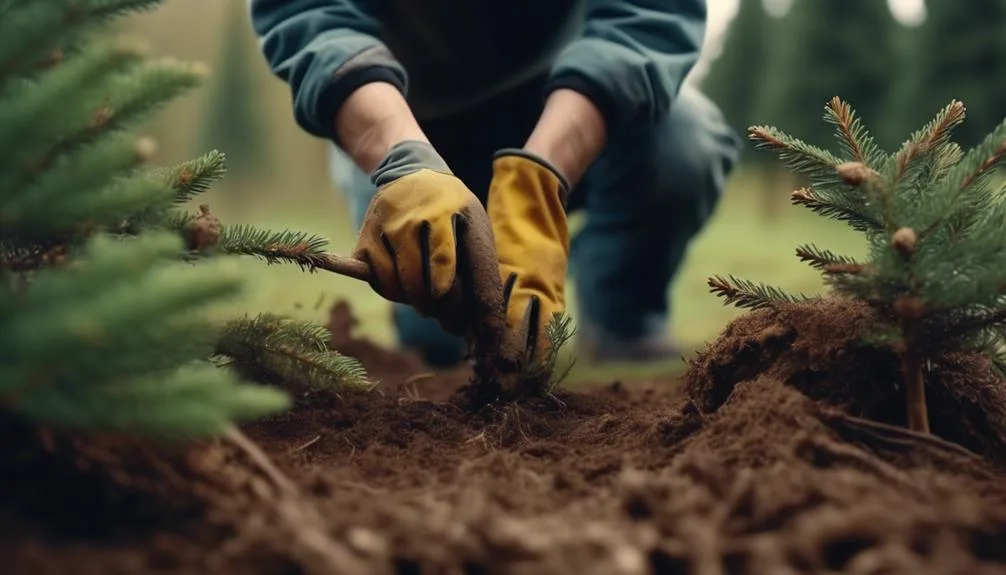Transplanting young spruce trees can be a delicate task, but it doesn't have to be daunting. By using careful techniques and timing, you can move these trees safely to a new location.
Wondering how to do it? We'll break down the essential steps for you.
With the right approach, you can ensure a successful relocation for your young spruce trees.
Selecting the Right Location
Before transplanting young spruce trees, there are several important factors to consider. First, you need to select a location with well-draining soil and ample sunlight. Suitable soil is crucial for successful transplantation. Look for loamy, well-aerated soil that allows water to drain easily. This is important to prevent waterlogging, which can lead to root rot and other diseases. Additionally, ensure that the chosen spot receives at least six hours of direct sunlight each day. Adequate sunlight is vital for the trees' growth and overall health. Lastly, check for potential hazards such as nearby structures or overhead power lines that could impede the tree's growth or pose safety risks. Taking these factors into consideration will set the stage for successful transplantation and the healthy growth of your young spruce trees.
Preparing the Transplant Site
To prepare the transplant site for your young spruce trees, assess the soil quality and remove any existing vegetation that may hinder their growth. Ensure the soil is well-draining and rich in organic matter. Consider root pruning if the trees have been in their current location for an extended period. Here's a helpful guide to prepare the transplant site:
| Soil Preparation | Root Pruning |
|---|---|
| Assess soil quality | Consider root pruning |
| Remove vegetation | |
| Ensure good drainage |
After preparing the soil, establish a watering schedule to keep the young spruce trees adequately hydrated. Additionally, apply a mulching technique to help retain moisture and regulate soil temperature. These steps will create an optimal environment for your young spruce trees to thrive after transplantation.
Digging up the Young Spruce Tree
Now, it's time to carefully excavate the young spruce tree, ensuring you preserve its root system for successful transplantation.
Begin by digging a trench around the tree, keeping it at a distance of about 12 inches from the trunk. This trench should define the size of the root ball.
As you dig, gently loosen the soil to expose the roots. Be mindful to preserve as much of the root system as possible.
Once the trench is completed, use a shovel to undercut the root ball, ensuring to keep it intact.
Lift the tree using the root ball and transfer it to the new location promptly.
Throughout this process, maintaining the integrity of the root ball and preserving the surrounding soil is crucial for the young spruce tree's successful transplantation.
Transplanting and Settling the Tree
Carefully choose the new location for the young spruce tree, ensuring it has suitable soil, sunlight, and adequate space to thrive. When transplanting the tree, prioritize root health. Handle the roots gently, avoiding damage.
Prepare the new planting hole before removing the tree from its original location to minimize the time the roots are exposed. Once the tree is in its new spot, settle the soil around the roots to eliminate air pockets.
After transplanting, establish a regular watering schedule. Water deeply and slowly to encourage the roots to grow downwards. During the first year, monitor the moisture levels closely, especially during dry periods. Proper watering is crucial for the tree to overcome the shock of transplantation and to promote healthy root development in its new environment.
Caring for the Transplanted Spruce Tree
After transplanting the young spruce tree, you should continue to provide regular and deep watering to support its adjustment to the new environment. Here are a few essential care tips for your transplanted spruce tree:
- Watering Schedule
- Water the tree deeply once a week, ensuring the soil is moist down to the root zone.
- During dry spells, increase watering frequency to prevent the roots from drying out.
Remember to monitor the soil moisture regularly and adjust the watering schedule as necessary to maintain optimal conditions for the transplanted spruce tree.
Additionally, consider researching pruning techniques specific to your spruce tree variety to promote healthy growth and shape the tree as it continues to thrive in its new location.
Conclusion
With regular watering, attentive monitoring, and some shade in the initial weeks, your transplanted spruce tree will flourish and enhance your landscape.
Happy planting and may your efforts be rewarded with the beauty of a thriving tree!

My interest in trees started when I first saw the giant sequoias in Yosemite.
I was a teenager then, and I remember thinking, “I need to learn more about this.”
That moment stuck with me.
A few years later, I went on to study forestry at Michigan Tech.
Since graduating, I’ve worked in a mix of hands-on tree care and community education.
I’ve spent over ten years helping people understand how to plant, maintain, and protect the trees in their neighborhoods.
I don’t see trees as just part of the landscape.
They are living things that make a real difference in our daily lives.
